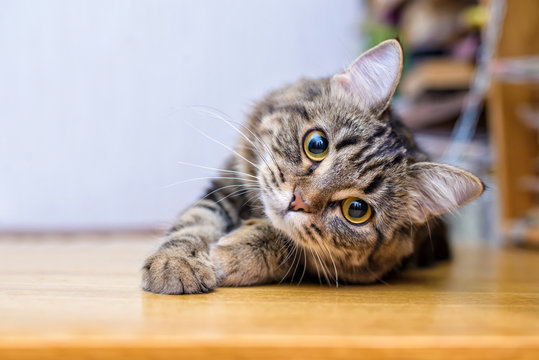How Cats Show Affection and Express Their Emotions
Cats have a reputation for being mysterious and aloof creatures, but anyone who has spent time around them knows that they are far more expressive than they might seem. Understanding how cats express emotions can deepen the bond between you and your feline friend, allowing you to respond to their needs and moods more effectively. In this blog, we’ll explore the various ways cats show affection, express emotions, and communicate with their owners, helping you become more attuned to your cat’s emotional world.
How Cats Show Affection: The Subtle Signs of Love
When it comes to showing affection, cats might not be as overt as dogs, but they have their own unique ways of letting you know that they care. How cats show affection can range from subtle gestures to more obvious displays of love.
One of the most common ways cats express affection is through purring. While why cats purr can sometimes indicate discomfort or illness, it is most often a sign of contentment. When your cat purrs while cuddling with you or when you pet them, it’s a clear indication that they are happy and comfortable in your presence. Purring can also serve as a form of self-soothing, so if your cat purrs after a stressful event, it’s their way of calming down.
Another affectionate behavior is kneading. Many cat owners wonder, why do cats knead? This behavior, where a cat presses its paws rhythmically against a soft surface, often harkens back to kittenhood. Kittens knead their mothers to stimulate milk flow, and adult cats may knead when they feel secure and content. If your cat kneads on you, consider it a high compliment—they see you as a source of comfort and security.
Cats also show affection through headbutting or “bunting.” This behavior involves your cat rubbing its head against you, which is not only a sign of love but also a way for them to mark you with their scent, signaling that you belong to them. These actions, along with slow blinking (often referred to as “cat kisses”), are clear indicators that your cat feels affection toward you.
Understanding Cat Emotions: Do Cats Feel Emotions Like Humans?
One of the most debated topics among pet owners and scientists alike is whether cats feel emotions in the same way humans do. While we may never fully understand the depth of feline emotions, there is evidence to suggest that cats do indeed experience a range of emotions similar to those felt by humans.
Understanding cat emotions involves recognizing that while their emotional range may not be as complex as ours, it is still significant. For instance, cats can feel joy, sadness, fear, and even jealousy. Do cats feel emotions like love? The consensus among many experts is yes, albeit in their own way. A cat’s bond with its owner can be seen as a form of attachment, similar to how humans form bonds with each other.
Cats express their emotions primarily through body language and vocalizations. For example, a cat that feels threatened might arch its back, puff up its fur, and hiss, while a happy cat might purr, knead, or show relaxed body language. Understanding these cues can help you respond appropriately to your cat’s emotional state.
Cat Body Language Guide: Decoding Feline Signals
To truly understand how your cat is feeling, you need to be fluent in cat body language. This silent form of communication can tell you a lot about your cat’s mood and intentions.
One of the most telling parts of a cat’s body is its tail. Cat tail language can be particularly revealing. A tail held high often indicates confidence and contentment, while a tail tucked between the legs can signify fear or submission. If your cat’s tail is puffed up, it’s a sign that they are either scared or feeling threatened.
Another aspect of cat body language to pay attention to is their posture. A relaxed cat will often lie down with its belly exposed, a clear sign of trust. Conversely, a cat that is ready to pounce or feeling defensive will have a stiff body with ears flattened against its head.
Cats also communicate through their facial expressions. Cat facial expressions meaning can be subtle, but they are important indicators of how your cat is feeling. For instance, dilated pupils might indicate excitement or fear, while half-closed eyes usually signal relaxation. Paying close attention to these expressions can help you better understand your cat’s emotional state.
The Vocal Side of Feline Communication: What Your Cat’s Meows Mean
While cats are often thought of as silent creatures, they can be quite vocal when they want to be. Understanding cats meowing meanings is key to deciphering what your feline friend is trying to tell you.
Cats use different types of meows to convey different messages. A short, soft meow might be a polite request for attention, while a loud, insistent meow could indicate that your cat is hungry or wants something urgently. Some cats even develop a specific meow that they use exclusively with their owners, further personalizing their form of communication.
In addition to meowing, cats may use other vocalizations such as trills, chirps, or growls to express their emotions. Trilling is often a sign of excitement or greeting, while growling or hissing is a clear indication that your cat feels threatened or angry. By paying attention to the context in which these sounds are made, you can better understand what your cat is trying to communicate.
Signs of a Happy Cat: How to Tell If Your Cat Is Content
Every cat owner wants to know that their feline friend is happy. Signs of a happy cat are usually easy to spot if you know what to look for.
A happy cat will often engage in playful behavior, such as chasing toys or playfully swatting at you. They will also exhibit relaxed body language, such as lying down with their belly exposed or curling up in a cozy spot. Purring, as mentioned earlier, is another strong indicator of contentment.
In addition to physical behaviors, a happy cat will also have a healthy appetite and good grooming habits. Cats that are feeling stressed or unwell might stop eating or neglect their grooming, so it’s important to keep an eye on these aspects of their behavior.
Building a Stronger Bond Through Understanding
Understanding how cats express emotions is key to building a stronger bond with your feline friend. By recognizing the ways in which cats show affection, understanding cat body language, and interpreting their vocalizations, you can respond to your cat’s needs more effectively and foster a deeper connection.
Cats may be mysterious, but with a little effort and attention, you can decode their signals and understand the rich emotional life that lies beneath their sometimes inscrutable exterior. Whether your cat is purring contentedly, kneading your lap, or meowing insistently, these behaviors are all part of how they express their emotions and communicate with you.
For more in-depth information on pet care and understanding animal behavior, visit Regent Studies, where you can find valuable resources to help you become an even better pet parent. And if you’re curious about the latest research on feline behavior, check out this external article on cat emotions.




